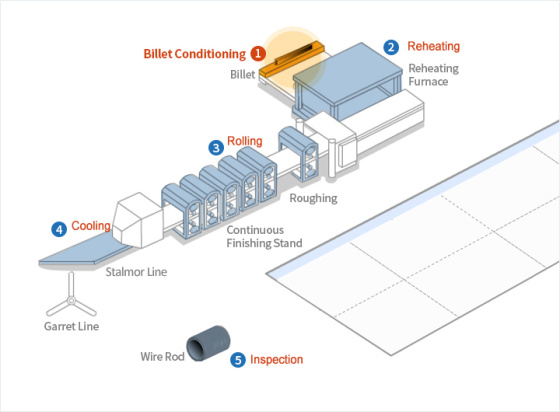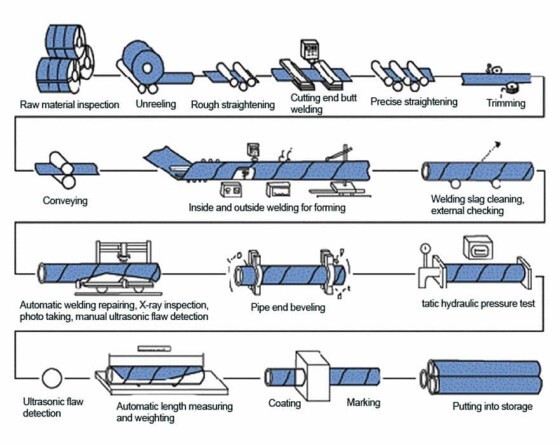
Processo de fabricação
 Steel PlateSteel Plate
Steel PlateSteel Plate1. Rolling: The 4-high reversible finishing mill with the maximum load of 7000 tons minimizes internal defects even inly thick plates. Automatic gauge control and shape control systems can reduce not only the thickness deviation of plates but also improve the flatness.
2. Cooling: The cooling system enables the production of high strength steel without heat treatment through rolling and accelerated cooling. Using the mist cooling method with suction type, the system has a high cooling capacity and is able to maintain a uniform temperature gradient in the widthwise direction. This leads to a reduction of plate quality deviation.
3. Hot Leveling: The hot leveler is used to make superior quality flat plates by eliminating residual stress left on rolled plates.
4. Slitting: After passing through the cooler, the plates undergo a dimensional accuracy inspection and then cut into appropriate width and length according to plate grade and thickness using either mechanical shearing machine or flame planner. To obtain a higher degree of dimensional accuracy in products, production conditions are determined by such factors as the air knife gap and the nozzle size of the gas torch.
5. Heat Treatment: To attain the plate structure demanded by customers, plates undergo heat treatment after having the scale removed by shot blasters. The heat treating facilities are of a non-oxidizing radiation tube type, which produces scale-free heat-treated plates.
6. Ultrasonic Tester Checks: The ultrasonic tester checks for blow holes, pipes, and laminations and other internal defects. This test is performed to guarantee the internal quality of plates demanded by customers.Saiba mais → Wire RodWire Rod
Wire RodWire Rod1. Billet Conditioning: This process is intended for checking the surface quality of billet and removing any defects. Shot blast is used to remove any scale from the surface. Magnet particle testing and visual inspection are also used to identify any defects which must be removed using a grinder. Ultrasonic testing and dimension and geometry checking are also applied as part of the internal quality assurance process.
2. Reheating: The temperature within the furnace and the duration of reheating depend on where the product will be used. To avoid decarburization, which can affect the surface quality of the product, a billet is pre-heated sufficiently at a low temperature before being rolled within the reheating furnace. For this purpose, the fuel and air ratio are strictly controlled.
3. Rolling: The temperature, draft and speed of deformation with which the product is rolled are controlled to meet customer requirements for material features. Further measures to ensure the surface quality include the adjustment of roll roughness and gap, detection of any cracks and dimension correction.
4. Cooling: Coiling temperature at the laying head, the air flow and movement speed of the blower on the cooling bed and the cooling speed of the insulation cover are controlled to ensure that the product has the features required for each application. High carbon steel Wire rods are subject to fast cooling to achieve the microstructure required for successful drawing while low carbon steel is subject to slow cooling to ensure that the product provides the softness required for the customer to eliminate an annealing process.
5. Inspection: Samples are taken from the front and rear edges of the product after rolling and cooling for testing to identify any defects in the dimension or surface or material integrity. Packaging and tagging are also inspected according to customer requirements prior to shipping.Saiba mais → Spiral Welded Pipe
Spiral Welded Pipe1.Uncoiling and Straightening: We need to have our carefully-selected steel plates of top quality straightened using the straightening machine to make them flat and straight, which lays a solid foundation for subsequent forming and welding.
2.Forming: Under the action of the forming machine, the steel plates pass through multiple passes of forming rollers and are gradually curled into a tube shape. During the molding process, it is crucial to control the spacing and speed of the rollers to ensure the accuracy of the tube diameter and wall thickness.
3.Internal and External Welding: We use advanced submerged arc welding machines and double-sided welding machines to achieve welding on both inner and outer sides. During the welding process, welding equipment and automatic tracking systems ensure the quality of welds.
4.Pipe Cutting: After welding is completed, we accurately cut the pipes using plasma technology according to the specified size.
5.Inspection: Advanced technical means such as ultrasonic flaw detector and X-ray inspection equipment are used to comprehensively inspect the weld to ensure its quality. In case of any defect, we need to carry out timely repair and welding until each welded pipe meets the standard.
6.Pipe End Processing: The spiral welded pipe is cleaned by a cleaning machine to remove oil stains and impurities on the surface. An Anti-corrosion treatment needs to be carried out through spraying equipment to provide long-term and effective protection for welded pipes. After this series of treatments, a high-quality spiral welded pipe is finally born.Saiba mais →

Deixe uma mensagem
Se você estiver interessado em nossos produtos e quiser saber mais detalhes, deixe uma mensagem aqui, responderemos o mais breve possível.



